Breast milk is a unique product that has no analogues in terms of its composition. It is important to familiarize yourself where does it come from in women, what are its benefits and what types of it are.
Record content:
- 1 Why is breast milk produced?
- 2 Composition and calorie content
- 3 Types of breast milk
- 4 How the composition of breast milk changes with the growth of the baby
- 5 Taste and color
- 6 Benefits of milk for your baby
- 7 Why is the feeding process useful?
- 8 Benefits of breastfeeding for mom
- 9 Breast milk videos
Why is breast milk produced?
Milk in women (where it comes from and how it is formed will be described below) begins to be produced even during the period when the child is in the womb. At the initial stage after childbirth, the level of the pregnancy hormone (progesterone) in the female body decreases and hormones responsible for milk production are involved in the work - these are insulin, prolactin and oxolin, which synthesized by the pituitary gland.
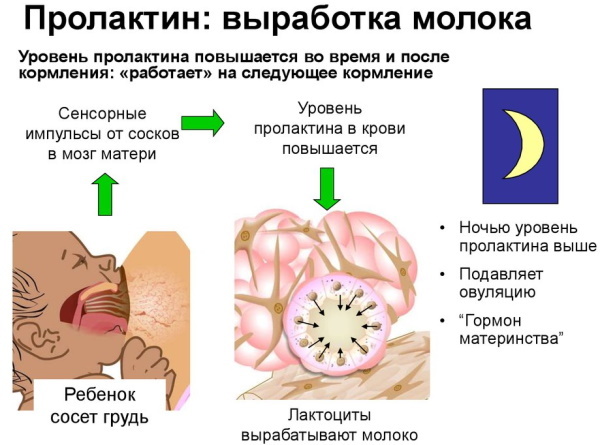
And as soon as the amount of prolactin in the body increases (this happens when a baby sucks on the breast), the brain begins to stimulate milk production. It is worth noting that babies are ready for breastfeeding immediately after birth - the sucking reflex is innate.
Therefore, it is important to breastfeed your baby for the first 1–2 hours after birth.Even if there is no milk yet, this will start the process of milk production. Oxytocin helps push milk out of the breast (milk is formed in the glandular tissue of the breast, which is made up of the alveoli) through the contraction of certain muscle groups.
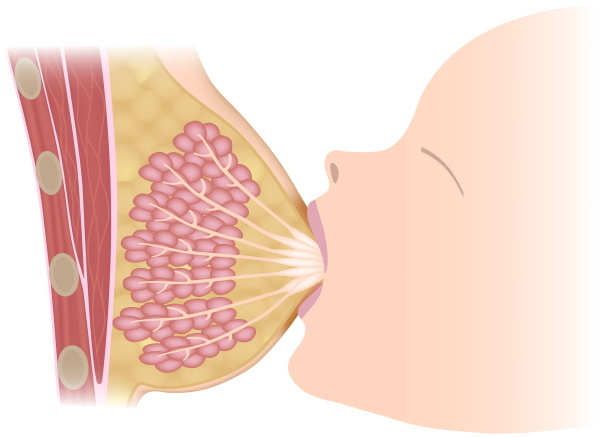
After that, milk enters the nipple through the milky ways, and the woman feels their swelling. And about the 3rd day after the birth of the baby, milk begins to arrive - this can be seen by the filling of the breast, it also becomes more firm.
Breast milk production is a complex process that will take about 1 month to form and normalize.
In the first few weeks, the woman's body learns to synthesize the product in the right amount. To establish this process, it is important to constantly breastfeed the baby. This will stimulate the production of prolactin, and as a result, the milk will gradually ripen and change in composition.

Even if at the beginning the child will eat very often, for example, every 40 minutes, there is nothing to worry about - frequent latching on to the breast and emptying it will help normalize the process of milk production (it will be formed by needs).
Composition and calorie content
Milk in women (where it comes from and what composition it is important to know to understand its nutritional value) contains about 500 different substances, but its main components are presented in the form:
- Biologically active water - it makes up 87% of the total amount of milk. This is the main component that is well absorbed by the child's body. With a full-fledged feeding, additional drinking is not required, since this water helps to quench thirst and does not contain salts or carbonates in its composition.
- Carbohydrates represented by lactose (make up 7%). It is responsible for the process of accelerating the development of the child's body, helps the better absorption of calcium, iron and bifidum factor, which is responsible for antifungal antibacterial protection. Also, carbohydrates contribute to the normalization of digestion. The lactose level in milk is constantly changing, gradually increasing. This is due to the need for a growing child's body in milk sugar for the development of mental activity and the nervous system. Half of the lactose contained is used for the development of neural functions, and the other half for the development of motor functions and skills.
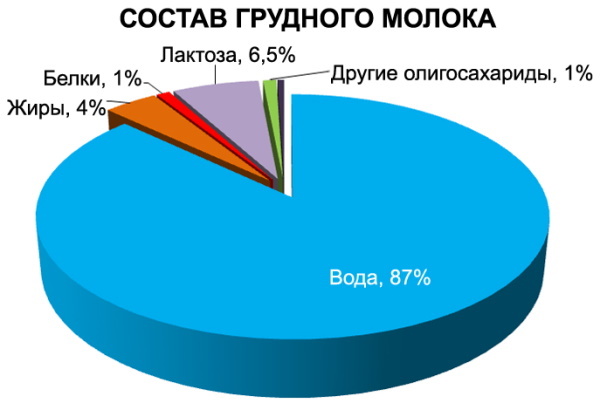
- Fats (contains about 4%) - they are responsible for strengthening the immune system and forming the nervous system. They have a unique structure, saturated with triglycerides, which are converted into useful substances in the child's digestive tract and are completely absorbed. It should be noted that throughout the entire lactation period, the amount of fat in milk remains practically unchanged.
- Protein (1%), which are the basis for the child's weight gain and correct growth. They contain a lot of lipase, nucleotides, taurine, protein lactoferrin. Their concentration gradually decreases: at first, 100 ml of milk contains from 2.3 to 5.5 g, and closer to the end of the act, their level drops to 1.5 g. but this amount is enough for the normal course of metabolic processes.
- Other components (presented in an amount of 1%), which are minerals, hormones, antibodies, leukocytes, amino acids, stem cells and vitamins.

By 18 months after the birth of a child, the concentration of nutrients in milk is reduced by 2-3 times, which reduces the value of breastfeeding. That is why, when the child reaches the age of one and a half years, it is recommended to stop lactation.
Milk also contains a special factor that partially suppresses lactation. It slows down the process of producing a new portion of milk if it has not been previously removed along with the liquid. This protects the breast from excess milk and minimizes the risk of hardening and mastopathy.
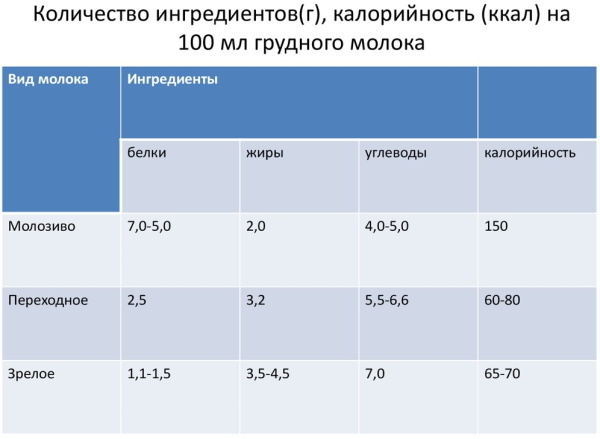
It is worth noting that milk production in a woman's body occurs around the clock, and its amount does not depend on the size of the breast. This factor is not affected by the amount of food consumed by a woman, because hormones stimulate milk production. But a varied diet with a predominance of healthy products affects the quality characteristics of milk.
The calorie content of milk varies depending on its type. So, colostrum is the most nutritious - it contains from 100 to 150 kcal. The calorie content of transitional milk is reduced to 70-75 kcal, and the nutritional value of permanent (mature) milk is in the range of 65-70 kcal.
With regular feeding, these indicators fully satisfy the child's nutritional needs. But if he is gaining weight poorly, then milk may have a low calorie content. This indicator can be checked in the laboratory by donating milk for analysis, or at home. To do this, the milk is decanted and left to stand for 6 hours.

If the milk is yellow, and there is a greasy coating on the walls of the dishes, this indicates a normal nutritional value. A white color with pronounced wateriness may indicate a low calorie content of milk.
Sometimes the cause of problems with underweight can be the feeding of the baby's front milk.
This liquid is located closer to the milk canals and is liquid and low-calorie. Thicker and more nutritious milk is concentrated at the base of the milk ducts. Therefore, the child may eat foremilk and not receive the full amount of nutrients.
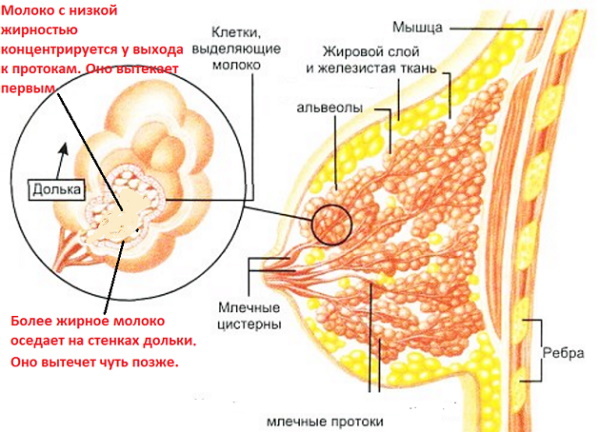
To avoid this, it is recommended:
- Feed from one breast for 2 hours.
- Before feeding, do a light breast massage (about 3-5 times a day).
- Take a comfortable position for feeding - the chest should hang over the baby.
- Express a small amount of milk before feeding.
Types of breast milk
Milk from women (where it comes from and what types of it are you need to study in advance for the correct organization of the feeding process) is divided into several types depending on age. Their description is presented in the table below.
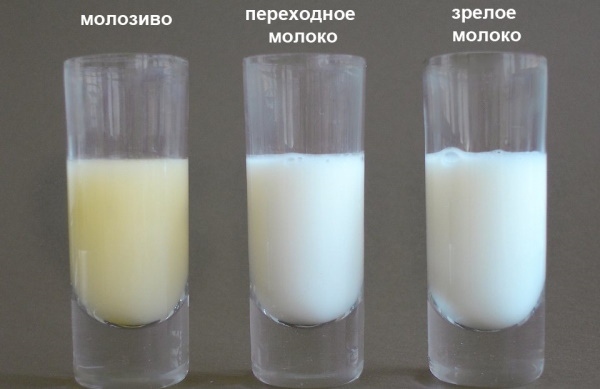
| Milk type | Peculiarities |
| Colostrum | It is a thick and sticky yellow liquid. It is produced in small amounts during the first 4-5 days after the baby is born. The composition of colostrum is similar to the blood serum of an infant, therefore it contains a lot of proteins, vitamins, leukocytes, salts, beneficial bacteria and immunoglobulin (therefore colostrum is often called the 1st vaccination child). These substances help to speed up the process of adaptation of the baby to a new way of feeding, therefore, newborns need to breastfeed during the first few hours after birth. It should be noted that the composition of colostrum changes throughout the days of its production. This allows you to provide the newborn's body with maximum protection. Even when a child is born before the prescribed time, the mother's body immediately begins to form and release fluid with the composition necessary for the newborn. For 2 weeks, it has a composition similar to colostrum, which allows the body to get stronger faster. |
| Transitional milk | Begins to be produced within 2-3 weeks after childbirth. In terms of composition, it is more nutritious than colostrum, but contains fewer protein components. This milk helps the child's body to adapt to a new way of life and new products. |
| Mature milk | It appears 3 weeks after the birth of the child and is more fatty. It contains less water and protein - the main part is fatty acids. They are responsible for the normal functioning of the brain. Normally, a woman produces about 1.5 liters of mature milk per day. |
In turn, mature milk is divided into 2 more types:
- Front milk. It is thinner, slightly blue in color and exudes during the first minutes of feeding. Milk contains a lot of salt, carbohydrates and water, which helps to quench the baby's thirst.
- Back milk. It has a thick consistency and a yellow tint, contains more nutrients, since it is a complete food for a child.
How the composition of breast milk changes with the growth of the baby
The composition of milk will change throughout the entire period of breastfeeding, adjusting to the needs of the baby. So, in the early days, it contains substances necessary for the formation of the body's immune defense and its adaptation to new living conditions.
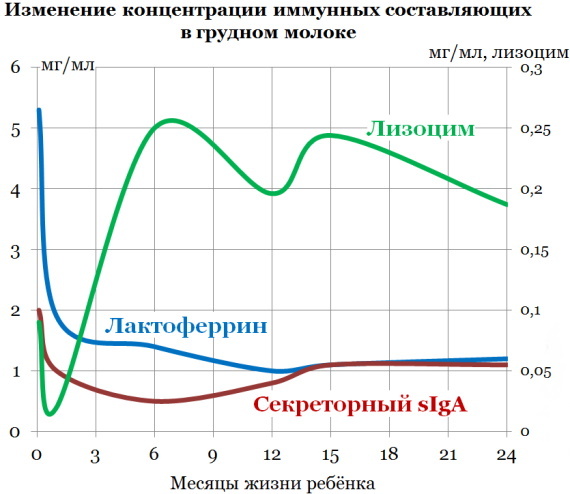
It also contains a lot of protein, the level of which gradually decreases. This is due to the ongoing changes in the child's digestive system - over time, a large amount of protein ceases to be absorbed and can cause problems with metabolic processes, the correct functioning of the nervous systems.
It also increases the risk of overloading the liver and causing obesity. Therefore, as the child grows, the amount of nutrients and components in milk increases, which are responsible for the correct development of all organs and systems at every stage.
Taste and color
Milk color and taste can be influenced by several factors:
- Feeding time. For example, milk has a thicker consistency and richer color during the day than at night.
- The diet of a nursing woman. The consumption of salty, spicy, smoked foods, alcohol, medicines and smoking has a great influence. They give the milk a characteristic flavor that the baby may not like. Also, such foods can cause problems with the digestive tract. It is recommended to limit the consumption of sweet, baked and fried foods - they make the milk too thick and it becomes difficult for the child to suck on it.
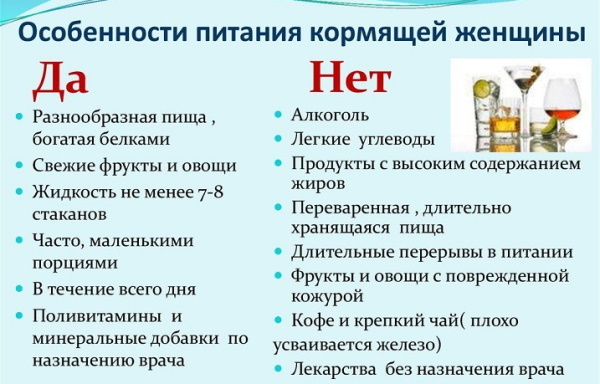
- Maternal health (both physical and emotional). Therefore, a nursing woman needs good rest, adherence to the principles of proper, balanced nutrition, giving up bad habits and, if possible, from medications. In the case of medication, it may take about 8-10 hours to break down. Therefore, it is recommended to express the first part of milk before feeding, because the greatest amount of harmful substances can be concentrated in it. You should not choose medicines on your own - it is better to consult a pediatrician. The doctor will help you choose the best option that will be safe for the child.
- Weather (in the cold season, the milk will be thicker, and at high temperatures, the product becomes watery).
- Baby activity during feeding.
Benefits of milk for your baby
Milk in women (where it comes from and what effect it has on the body is important to know for maximum benefit) during lactation, it helps not only to meet the nutritional needs of the child, but also contributes to:
- Protect against various bacteria.
- Reducing the likelihood of developing sudden infant death syndrome.
- Mental development.
- Reducing the risk of developing food allergies. For example, when a baby is weaned at the age of 1 year. and transferring it to cow or goat milk there is a high probability of developing an allergy to milk protein. And breastfeeding after a year allows you to prevent the occurrence of an allergic reaction in adulthood.
- Protect against the formation of cancer cells.
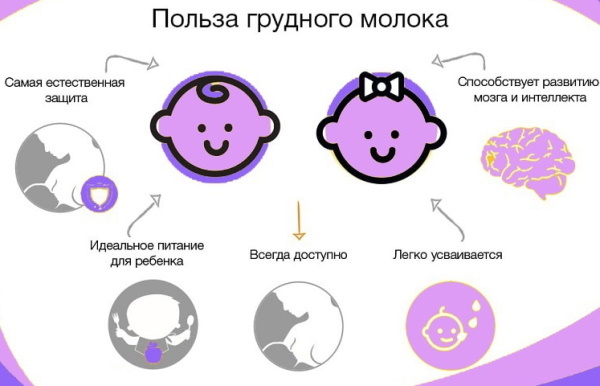
- Development of the muscles of the tongue, mouth and jaw apparatus, which will further help in the correct formation of speech.
- Rapid adaptation of the child's body to new food products due to the content of special enzymes.
- The ability to control the weight gain of the child, since substances are evenly distributed in the body. This reduces the risk of obesity, diabetes, hypertension, and other health problems.
- Prevention of the development of caries in the future and the formation of a correct bite due to constant sucking of the breast.
- Increase the immune response during vaccination.
- Formation of powerful immune defenses. For example, during a woman's illness, antibodies are formed in milk that help protect the baby.
The pronounced antibacterial properties of milk allow it to be used to heal various injuries of the skin, as well as to treat the common cold by nasal instillation.
Why is the feeding process useful?
During feeding, a special bond is established between the baby and the mother. It helps to maintain not only the physical but also the emotional health of the newborn - it is calms the child, relieves fears, helps to fall asleep faster and sleep soundly for several hours.

The consumption of breast milk reduces the risk of developing colic and other problems with the digestive tract, and also helps the body to withstand various stressful situations in the future.
Benefits of breastfeeding for mom
Breastfeeding is also beneficial for women:
- Helps recover faster after childbirth by reducing the risk of PPH and other health problems.
- Stimulates the production of the hormone oxytocin, which contributes to the rapid contraction of the uterus and its return to its usual state.
- The abdominal organs also return to their position more quickly.
- Prevention of breast, ovarian and uterine cancers by suppressing the production of estrogen (at a high level, it can provoke cancer).
- Prevention of bone weakness and bone problems, as the woman's body absorbs calcium well. Therefore, it is recommended to diversify the diet with dairy and meat products.
- Weight is reduced. Most women face this problem, because during pregnancy they gain extra pounds, which are not so easy to lose after giving birth.

- Strengthening the health of the reproductive system due to "rest" from the menstrual cycle (the process of ovulation is suppressed and there is no menstrual flow).
- The risk of developing diabetes decreases, because the sugar level during this period decreases and the likelihood of developing the disease decreases by 48%.
Breastfeeding also has a positive effect on a woman's emotional health.
During feeding, a large amount of endorphins is produced, which makes a woman calmer, happier and significantly reduces the risk of postpartum depression.
Also, frequent latching to the breast and the feeding process helps to develop the maternal instinct and awaken tender feelings for the child (sometimes, against the background of postpartum depression, women may withdraw from child).

Also, breastfeeding allows you to save money, because there is no need to buy infant formula. And it is also very convenient - fresh and high-quality food for the child is always nearby and there is no need to waste time preparing it.
Breastfeeding brings undeniable benefits to both the baby and the mother. Therefore, a woman is advised to create comfortable conditions for normalizing the process of milk production and improving its quality characteristics.
Breast milk videos
How breast milk is made:



